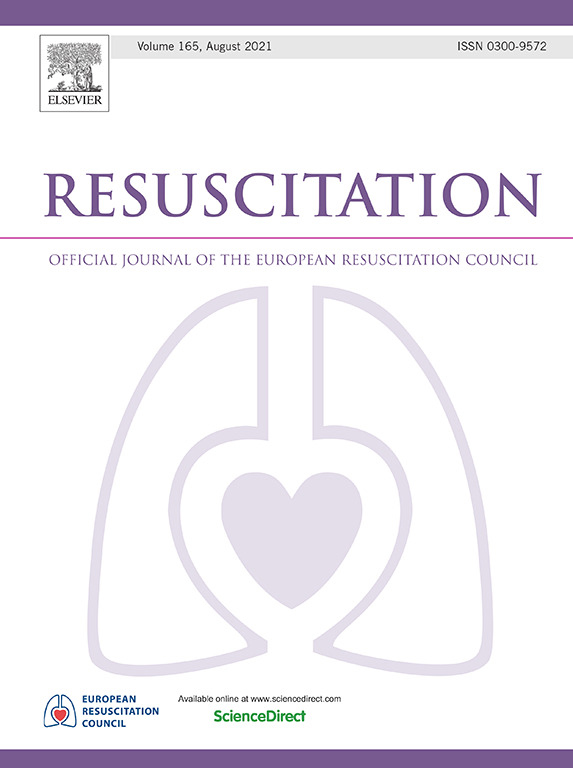Incidence and outcomes of out-of-hospital cardiac arrest from initial asystole: a systematic review and meta-analysis
IF 6.5
1区 医学
Q1 CRITICAL CARE MEDICINE
引用次数: 0
Abstract
Aim
To examine global variation in the incidence and outcomes of Emergency Medical Services (EMS) attended and treated out-of-hospital cardiac arrest (OHCA) from initial asystole.
Data sources
We systematically reviewed electronic databases for studies between 1990 and August 2024 reporting EMS-attended or treated asystolic OHCA populations. The primary outcome was survival to hospital discharge or 30-days. Random-effects models were used to pool primary and secondary outcomes and meta-regression was used to examine sources of heterogeneity. Study quality was assessed using the Joanna Briggs Institute critical appraisal tool for prevalence studies.
Results
The search returned 4464 articles, of which 82 studies were eligible for inclusion encompassing 540,054 EMS-treated patients across 35 countries. Five studies reported on EMS attended populations (n = 35,561). The studies included in the review had high clinical and statistical heterogeneity. The pooled proportion of EMS-treated initial asystolic OHCA was 53.0% (95% CI: 49.0%, 58.0%; I2 = 100%). The overall pooled proportion of survivors to hospital discharge or 30-days was 1.5% (95% CI: 1.2%, 1.8%, I2 = 97%). The pooled proportion of event survivors was 11.6% (95% CI 6.5%, 17.8%, I2 = 99%), the pooled proportion of prehospital ROSC was 16.0% (95% CI 14.0%, 17.0%, I2 = 100%) and the pooled proportion of neurologically favourable survival at longest follow-up was 0.6% (95% CI 0.5%, 0.8%, I2 = 100%). The overall pooled incidence of EMS-treated asystolic OHCA was 11.0 cases per 100,000 person-years (95% CI: 10.5, 11.5, I2 = 100%). In stratified analysis of survival to hospital discharge or 30-days, population type, study duration, study design and aetiology were the only variables that were significantly associated with survival to hospital discharge or 30-days. In adjusted analysis, population type, study duration, highest EMS skill level and region were significantly associated with the primary outcome. In the multivariable analysis of incidence, study region, arrest aetiology, sample size, year of publication, study population, study duration and study quality significantly explained variation in incidence across studies.
Conclusion
Initial asystolic OHCA made up 53% of all EMS-treated patients and pooled survival rates were extremely poor. Research efforts in this population should focus on developing prevention strategies as well as adherence to termination or withholding of resuscitation guidelines for asystolic OHCA.
院外心脏骤停的发生率和结果:一项系统回顾和荟萃分析
目的:研究急诊医疗服务(EMS)参与和治疗的院外心脏骤停(OHCA)的发生率和结果的全球变化。数据来源:我们系统地回顾了1990年至2024年8月期间报告ems参加或治疗的心脏骤停性OHCA人群的研究的电子数据库。主要终点是存活至出院或30天。随机效应模型用于汇总主要和次要结果,并使用元回归来检查异质性的来源。研究质量采用乔安娜布里格斯研究所流行病学研究的关键评估工具进行评估。结果:检索返回4464篇文章,其中82项研究符合纳入条件,涵盖35个国家的540,054名ems治疗患者。五项研究报告了EMS就诊人群(n= 35,561)。纳入本综述的研究具有较高的临床和统计异质性。ems治疗的初始停搏期OHCA合并比例为53.0% (95% CI: 49.0%, 58.0%;I2 = 100%)。出院或30天幸存者的总合并比例为1.5% (95% CI: 1.2%, 1.8%, I2 = 97%)。事件幸存者的合并比例为11.6% (95% CI为6.5%,17.8%,I2 = 99%),院前ROSC的合并比例为16.0% (95% CI为14.0%,17.0%,I2 = 100%),最长随访时神经系统有利生存率的合并比例为0.6% (95% CI为0.5%,0.8%,I2 = 100%)。ems治疗的无收缩期OHCA的总合并发病率为11.0例/ 100,000人年(95% CI: 10.5, 11.5, I2 = 100%)。在对出院或30天生存率的分层分析中,人群类型、研究持续时间、研究设计和病因学是与出院或30天生存率显著相关的唯一变量。在调整分析中,人群类型、研究持续时间、最高EMS技能水平和地区与主要结局显著相关。在发病率的多变量分析中,研究区域、病因学、样本量、发表年份、研究人群、研究持续时间和研究质量显著解释了不同研究之间发病率的差异。结论:初始停搏期OHCA占所有ems治疗患者的53%,总生存率极低。在这一人群中的研究工作应侧重于制定预防策略,以及遵守终止或暂停心脏骤停期OHCA的复苏指南。
本文章由计算机程序翻译,如有差异,请以英文原文为准。
求助全文
约1分钟内获得全文
求助全文
来源期刊

Resuscitation
医学-急救医学
CiteScore
12.00
自引率
18.50%
发文量
556
审稿时长
21 days
期刊介绍:
Resuscitation is a monthly international and interdisciplinary medical journal. The papers published deal with the aetiology, pathophysiology and prevention of cardiac arrest, resuscitation training, clinical resuscitation, and experimental resuscitation research, although papers relating to animal studies will be published only if they are of exceptional interest and related directly to clinical cardiopulmonary resuscitation. Papers relating to trauma are published occasionally but the majority of these concern traumatic cardiac arrest.
 求助内容:
求助内容: 应助结果提醒方式:
应助结果提醒方式:


